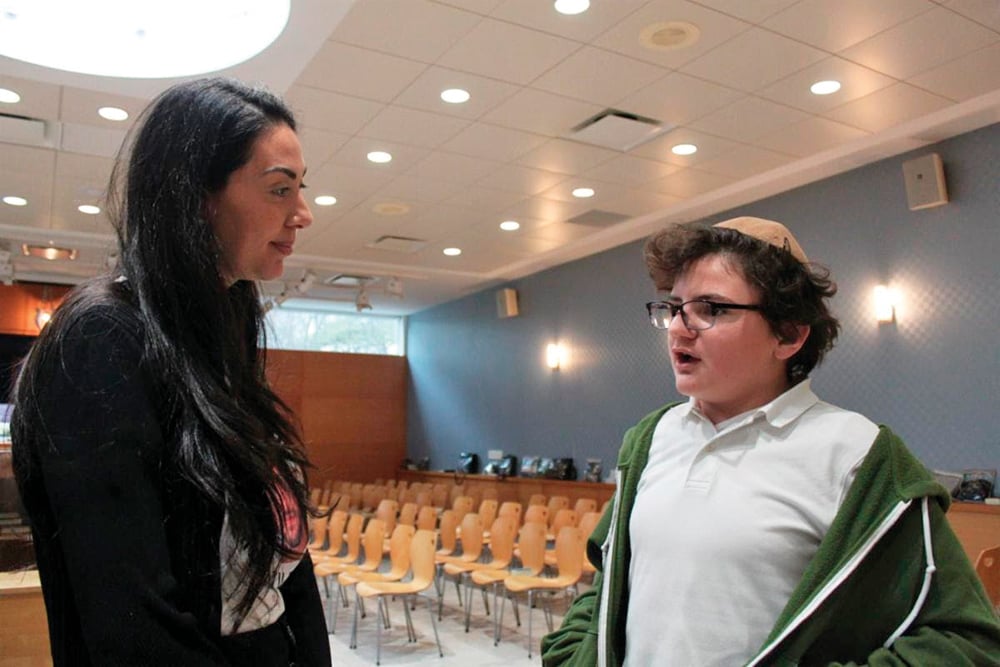RCA and OU
In October 2015, the Rabbinical Council of America issued a resolution (that I sponsored) that its members may not ordain women into the Orthodox rabbinate nor hire a woman rabbi, regardless of title. This past Thursday, after a long process of communal comment and rabbinic inquiry, the Orthodox Union (OU) issued a statement effectively adopting the above resolution, with an accompanying study of the subject by seven leading rabbis. When we face changing times and perplexing religious questions, we direct our inquiries to leading rabbis, as Jews have done for millennia. I commend the OU for following this time-honored process. The OU also opened the door for discussion with many community members, particularly women, as described in the organization’s statement. To my knowledge, this remarkable process of policy setting is unprecedented in its openness. When mechitzah became an issue that divided the Orthodox community and eventually set the standard for Orthodoxy, the process for determining this standard was much less transparent and open. The issue of women rabbis, which is the mechitzah of this generation, is being handled with much more patience and openness.
Even though I write extensively about halachah, I do not claim the expertise of the senior rabbis—roshei yeshiva and shul rabbis, authors and frequent responders to inquiries—who wrote the response to the OU. Of course, I defer to them for their greater knowledge, wisdom and responsibility. These are rabbis who answer questions on life-and-death halachah, who spend days and nights with people struggling in life, who teach thousands of students and guide hundreds of rabbis. In this case, we largely reached the same conclusion, although I would have followed their conclusion if we did not.
However, I don’t think halachah is the only question or answer in the issue of women rabbis. There is a moral element, as well, that underlies the sensitive rabbinic response and should resonate particularly strongly within the Modern Orthodox community. Of course, we accept the rabbinic conclusion. But how do we process it? How do we incorporate this direction into our mindset?
Religion and Inequality
The term “Modern Orthodox” is, in a sense, self-contradictory, which makes you wonder why it has been used for so long as a description of a significant portion of the Jewish community. The “Orthodox” part refers to the community’s strong commitment to traditional core beliefs and practices. The “Modern” part implies a willingness to absorb practices and values from contemporary culture. Sometimes the two complement each other but often they conflict.
As moderns, we instinctively maintain the equality of all people and uphold their freedom to choose their own paths without legal or social impediments. But this presents a challenge to Judaism, which limits certain positions to particular categories of people.
During the times of the Temples in Jerusalem, priests had different roles, privileges and responsibilities than Levites, who in turn had different roles than Israelites. While in the absence of the Temple these large role distinctions no longer apply, Jewish life retains minor differentiations (e.g. priests are called to the Torah in synagogue first, followed by Levites and then Israelites) and, perhaps more significantly, Orthodox Jews eagerly await the Messianic Era when these ancient divisions of classes and roles will be reinstated. How are we moderns to view the different privileges and responsibilities given to some people merely because they were born to priestly parents?
The case of bastardy is even more difficult. Unlike the vague colloquial usage, in Jewish law the case is highly defined – the child of a technically-defined incestuous relationship or of a union between a married Jewish woman and a Jewish man who is not her husband. Such a person is considered a “mamzer” and may only marry another “mamzer,” which is a heartbreakingly severe disadvantage. Again, the modern notion of equality seems to argue against this rule.
Women’s Issues
There are more examples, of course, but particularly pressing today is the question of the role of women in the Orthodox Jewish community. The amply attested tradition is that women are exempt from most time-bound positive commandments. Additionally, they are exempt from being called to testify before a religious court. These two exemptions logically lead to the exclusion of women from public roles in Jewish ritual. For example, because a woman is not obligated to hear the blowing of a shofar on Rosh Hashanah, even if she chooses to do so she cannot blow a shofar in synagogue for the benefit of others who are obligated to hear it. The same applies to leading public prayer and reading the Torah in synagogue. Her lack of obligation prevents her from performing the acts on behalf of those who are obligated.
While women were excluded from public ritual for thousands of years without much debate, the modern value of equality challenges that tradition. By what moral justification does our tradition differentiate based on gender? The challenge is particularly strong because Judaism sees moral intuitions as legitimate religious directives.
In the late 1970s and early 1980s, the Conservative Jewish movement debated exactly this issue in the context of the rabbinic ordination of women. The issue was so contentious that the final decision to ordain women led to a schism within the movement. Along the way, the Conservative debate produced three opposing views that are instructive:
Three Methods of Resolution
Rejectionism—an approach that openly acknowledges the conflict and allows tradition to prevail. Accepting the differentiation of gender roles, rejectionism holds that there is a profound spiritual reason for limiting the roles of women in public rituals, one that should be celebrated rather than dismissed. This is a resolution through rejection. As believers in the Divine revelation of Jewish tradition, which Orthodox Jews proudly profess, those who follow this approach reject any value that contradicts it in spirit or in law.
Legalism—an approach that treats the matter merely as a regular legal inquiry: What does Jewish law say about the ordination of women? Setting aside all issues that relate to theology and ethics, legalists allow the legal texts to speak for themselves—which in practice, leads to the same answer as the rejectionists—no. This was the approach of the leading Talmudist of the Conservative movement and continues to be maintained by leading Orthodox scholars.
Revisionism—an approach that redefines Jewish law to accommodate modern values. While insisting that it upholds the primacy of Jewish law, it undermines the values that inform tradition by a radical restatement of those laws. This approach has, on rare occasion, been implemented by eminent authorities in the past and has been adopted, and perhaps expanded, for the purposes of women’s public participation. For example, Jewish law does not allow a woman to be called to the Torah in synagogue, but a revisionist strategy would redefine “ascending to the Torah” as merely a ceremonial rather than religious role that has the effect of preserving the form while neutralizing the restriction. This type of redefinition and expansion is done to as many areas of opportunities formerly limited to women as possible.
Each approach has its advantages and drawbacks. The rejectionist approach seems truest to tradition, but by simply denying our modern moral intuition, it fails to take seriously the tension many genuinely feel. The legalist approach, meanwhile, purports to have a neutral view, but only succeeds in doing implicitly what rejectionism does explicitly—ignoring the ethical questions facing religious people today.
The revisionist approach seems to resolve the tension but does so at the expense of transforming public worship into an arbitrary collection of rituals. To include women in public rituals, revisionism has to deprive those practices of their religious significance, and to allow for women’s ordination, remove all aspects of communal authority from the rabbinate. In its own way, this leaves the moral dilemma intact. Additionally, there are some rituals that are immune to redefinition within the boundaries of the Orthodox legal process. Revisionism is resolution through procrastination, delaying the dilemma so that it only becomes troublesome at a later date when full egalitarianism comes face to face with a halachic brick wall.
If none of these approaches seems satisfying, perhaps we have put the question in the wrong way. Jewish decision-making is not about choosing between absolute right and absolute wrong. It requires weighing the issues to maximize right and minimize wrong. Modern Jews face not simply a conflict between tradition and ethics, but a matrix of demands that includes ethics, customs, history, community, and education. Each of these must be weighed by its importance to Judaism. Sometimes specific values are so powerful that they override all other considerations. Some innovations are relatively unobtrusive and the “slippery slope” argument does not seem conclusive, while others are driven by an agenda whose momentum guarantees further changes in the near future. So how do we weigh all of these considerations?
Religious Education
In a landmark 1994 article, Dr. Haym Soloveitchik described a shift in practice within the Orthodox Jewish community that encompasses, but is not limited to, a trend towards stricter practice. He attributed this to a change in methods of religious instruction. Previously, religious practice had been primarily taught at home through experiencing the family’s and local community’s practices. With a breakdown in families and communities, religious instruction shifted to schools and books. The written law is sometimes different from how it is practiced in various locales. The new approach to education led to a centralization of religion and, to a degree, a move towards the strictest common denominator. What Dr. Soloveitchik described was a move away from the experienced mimetic education towards the institutional education.
Many in the Modern Orthodox community object to this trend because it negates the practices they know. They were raised with a Judaism that is contradicted by the new textual standards. Those who cling dearly to their mimetic practices would want this value—the educational experience of Judaism as it was practiced in their youths—included in any evaluation of religious practices. In the case under discussion, it is clear that mimetic practice argues against increasing roles for women in the synagogue and the ordination of women. Such changes would do significant damage to this form of religious education.
Customs
A related issue is that of continuity of communal custom. This is not the same as the value just discussed: that is individual while this is communal; and that is about education while this is about stability. There is a requirement within Jewish law to maintain the continuity of custom, as can be seen from a number of customs that are steadfastedly retained—such as waiting for hours before eating dairy after a meat meal or the Ashkenazic custom to refrain from eating legumes on Passover due to their Medieval uses. This continuity of custom is important even in a case such as ours where we are discussing the absence of a practice—the lack of expanded roles for women in the community.
Women never served as ritual slaughterers, for example, although an actual prohibition was rejected in the Medieval legal literature. When the question arose of whether a woman could, in actual practice, be appointed as a slaughterer of animals, the answer given by scholars who are authoritative in the Ashkenazic tradition was no. Analogously, even if it is conceptually possible for women to serve as rabbis, communal custom—no small matter in the Jewish tradition—rejects the possibility, just as it rejects women prayer leaders and Torah readers.
History and Community
The slippery-slope argument must be given its due. As a culture, Judaism embraces history as a source of inspiration and a means for studying personal and communal strategies. Over the past two centuries, radical changes in communal structure and religious practice have proved, in every case, impossible to control. The evidence seems clear that when radical innovations to ritual originate within tight legal limitations they quickly exceed those bounds.
The Orthodox response to these changes has been to maintain the consistency of ritual conservatism. Orthodoxy has refused to legitimate non-Orthodox changes to Jewish practice by giving even the appearance of adopting liberal positions. This has been confirmed in responsa by leading Modern Orthodox scholars, such as Rav David Hoffmann, Rav Yechiel Weinberg and Rav Yitzchak Herzog, among others.
Certainly, egalitarianism is a value to be considered, but so is communal unity. There can be no question that the ordination of women would divide the Orthodox community. Whatever their reasons, the majority of Orthodox Jews will essentially excommunicate congregations and organizations led by women rabbis or allowing women to preside at Jewish rituals. Local rabbinical councils would split in half; schools would have to choose sides when making hiring decisions; family members would refuse to attend weddings over which a female rabbi presides.
Putting the Pieces Together
We can now consider all of these values and how they fit together in our evaluation of the proposed innovations of the ordination of women and expansion of the leadership roles of women in religious ritual. What had initially seemed like a conflict between tradition and ethics now looks somewhat different. We have multiple values that include ethics, customs, history, community, education and other important issues, which point in different directions. Not every value has equal weight; you cannot simply add up the values on each side of the debate and follow the majority because some values are more important than others.
While we defer to halachic scholars, in internalizing their conclusions the thinking person needs to consider each value and how important it is to him personally and to Judaism in general. Not every “slippery slope” argument is conclusive and sometimes specific values are so powerful that they override all other considerations. Some innovations are relatively unobtrusive and don’t offend other values while others are accompanied by a momentum and agenda that all but guarantee further changes in the near future. How do we weigh all of these considerations?
This process is no simple exercise. Evaluating religious values requires careful attunement to communal trends and, more importantly, to the rhythms of Judaism, something accomplished only through extensive study and with great sensitivity. This type of values-analysis will yield confusing and occasionally contradictory results. Some areas of women’s participation have different values-combinations than others. Depending on the specific practice, the measures on the scale will tip in different directions.
This type of values-analysis points to the conclusion that ordaining women and changing their roles in public ritual are not allowed, as indeed the leading rabbis have concluded. The kind of values-analysis I’ve been conducting does not resolve our moral problem—but that is not the point. The main outcome is not the conclusion but the process, through which we become more aware of the conflicting elements of the dilemma.
As with many issues—such as the differences between priests, Levites and Israelites, and the case of bastardy—we sometimes live with difficult ethical dilemmas because we recognize that change would cause more damage than preservation. We understand that the moral imperative of egalitarianism does not automatically trump all other values.
Living with conflicting moral demands is difficult, but is integral to developing and maintaining awareness of the complex ethical world in which we function, and it is the only way to grow and thrive as moral beings. We use the oxymoronic term “Modern Orthodox” not because we have found a way to resolve all difficulties but because we are willing to acknowledge the importance of multiple values. And we attempt to balance their demands without negating them.
Rabbi Gil Student, a Jewish Link contributor, is the editor of Torahmusings.com.













